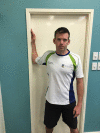EXERCISE REHABILITATION IN THE NON-OPERATIVE MANAGEMENT OF ROTATOR CUFF TEARS: A REVIEW OF THE LITERATURE
- PMID: 27104061
- PMCID: PMC4827371
EXERCISE REHABILITATION IN THE NON-OPERATIVE MANAGEMENT OF ROTATOR CUFF TEARS: A REVIEW OF THE LITERATURE
Abstract
The incidence of rotator cuff tears increases with age, with full-thickness rotator cuff tears present in approximately 25% of individuals in their sixties, and more than 50% of those in their eighties. While surgery is considered an effective treatment, recurrent tears at the insertion site are common, especially with degenerative tears, which are frequent in the older population. More recently, there has been increasing interest in exercise rehabilitation and physical therapy as a means to manage partial and full thickness tears of the rotator cuff by addressing weakness and functional deficits. Recent studies have suggested that patients opting for physical therapy have demonstrated high satisfaction, an improvement in function, and success in avoiding surgery. When considering the increasing rate of shoulder surgery and the associated economic and social burden rotator cuff surgery places on both the patient and the health care system, non-surgical management such as physical therapy and exercise may, in selected cases, be a treatment alternative to surgical repair. The purpose of this clinical commentary is to provide an overview of rotator cuff pathology and pathogenesis, and to present an evidence-based case for the role of conservative rehabilitation in the management of rotator cuff injuries.
Level of evidence: Level 5.
Keywords: Conservative management; exercise rehabilitation; physical therapy; rotator cuff tear.
Figures












References
-
- Fehringer EV Sun J VanOeveren LS Keller BK Matsen FA. Full-thickness rotator cuff tear prevalence and correlation with function and co-morbidities in patients sixty-five years and older. J Shoulder Elbow Surg. 2008;17(6):881–885. - PubMed
-
- Moosmayer S Lund G Seljom U, et al. Comparison between surgery and physiotherapy in the treatment of small and medium-sized tears of the rotator cuff: A randomised controlled study of 103 patients with one-year follow-up. J Bone Joint Surg Br. 2010;92(1):83–91. - PubMed
LinkOut - more resources
Full Text Sources
Medical
Research Materials
